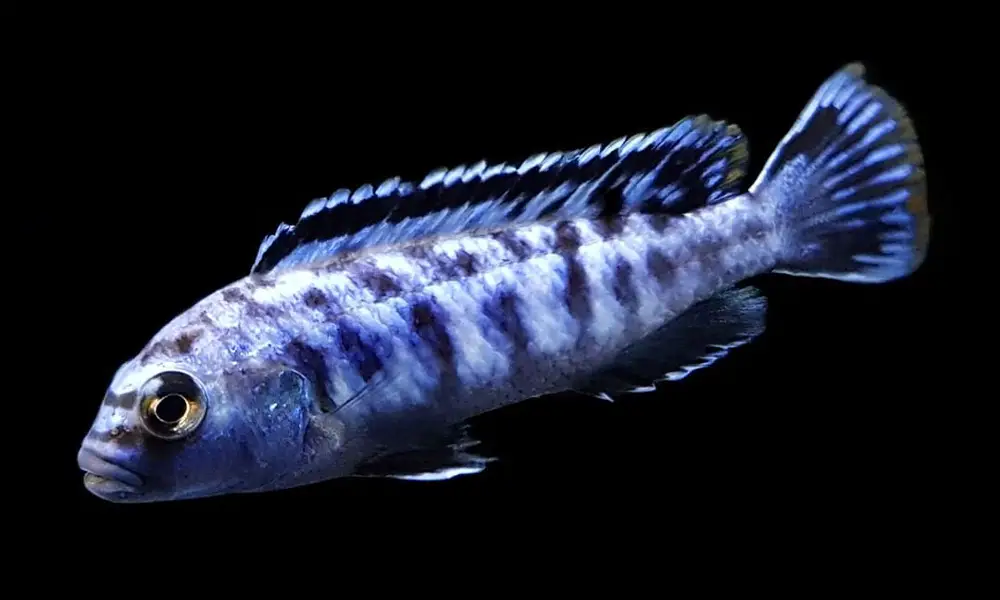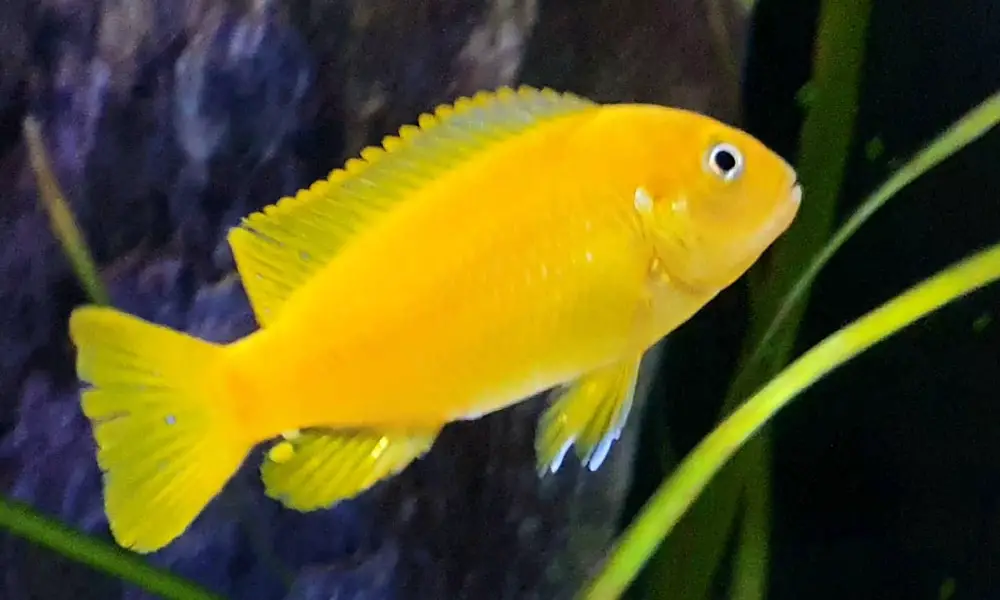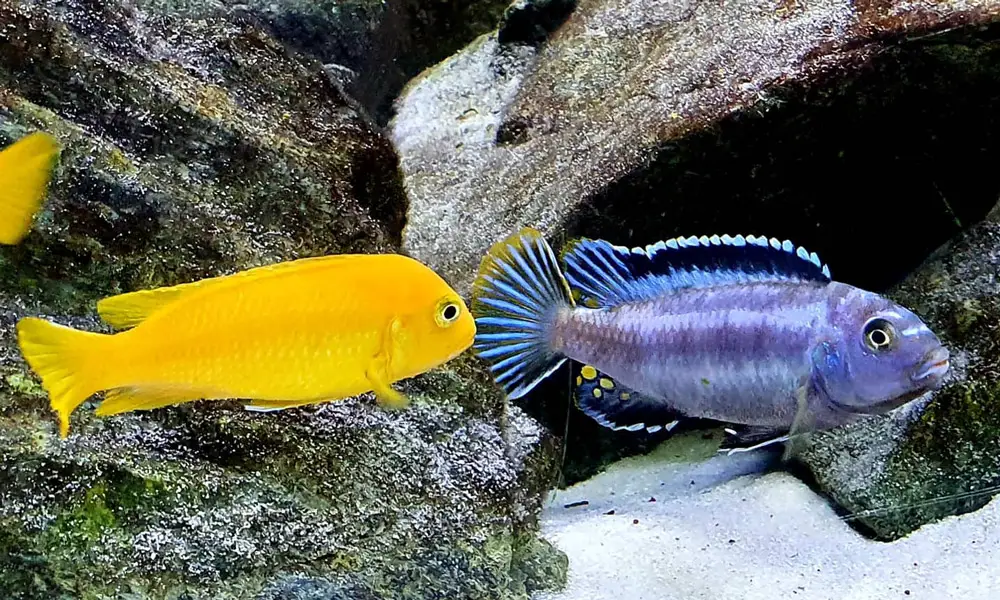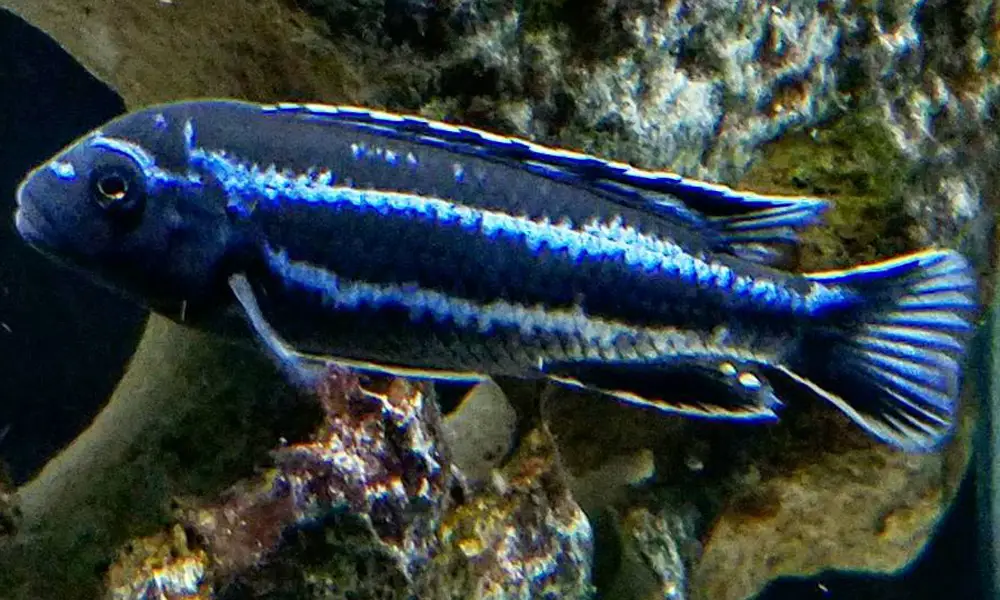An ideal species for seasoned aquarists, Johanni Cichlid is a common fish found in your Local Fish Stores. Its electrifying blue color makes this fish looks visually appealing, offering a charisma to the Rift Lake Cichlid aquarium.
While they look incredibly beautiful, Johanni Cichlids are highly active and aggressive Mbuna. Their aggressive temperament makes them slightly challenging to care for.
If you’re looking for this appealing fish of your own, it’s important to know what kind of habitat and tank mates they need in order to stay healthy and happy. Keep reading to learn everything you need to know about caring for Johanni Cichlid.
Species Summary
Johanni Cichlid was formerly a member of Melanochromis, but due to the differences in appearance, they are now classified as Pseudotropheus with the scientific name Pseudotropheus johannii, which is named to honor the fish collector from Lake Malawi, namely John Johns.
They are also commonly known as Blue Mbuna, Electric Blue Johanni, Blue Johanni, or Bluegray Mbuna. The term “Electric Blue” cause some confusion since this is also the common name of another popular African cichlid, the Electric Blue Hap (Sciaenochromis fryeri). They are two different species; the former belongs to Mbuna groups, while the latter is a member of Haplochromis(Haps) groups.
The Blue Mbuna is native to the nearshore zones on the eastern shore of Lake Malawi, south of Chuanga. They are also found around the Mozambique coastline of the Lakes. Like most Mbunas, this fish inhabits among the small and medium-sized rocks at depths of about 16 feet (5 m).
| Scientific Name: | Pseudotropheus johannii |
| Common Name: | Blue Mbuna, Electric Blue Johanni, Blue Johanni, or Bluegray Mbuna |
| Origin: | Lake Malawi |
| Aggressiveness: | Aggressive |
| Max Size: | 3″ (7.5 cm) |
| Lifespan: | 12 years |
| pH: | 7.7 – 8.6 |
| Temperature: | 73 to 82 F |
| KH: | 9 – 19 dGH |
| Minimum tank size: | 75 gallons (48″ x 18″ x 21″) |
| Diet: | Omnivore |
Appearance

With its brilliant blue body and torpedo shape, the Johanni Cichlid is a truly eye-catching fish that will definitely add ‘spark’ to a Mbuna aquarium.
Johanni Cichlids have a very elongated and thin body shape. This makes them quite speedy and hydrodynamic. The rounded snout with a small blunt tip helps them to forage for food in small spaces.
This species is sexually dimorphic, which means that you can easily distinguish the male and female fish.
Male Johanni Cichlids are bright blue with a prominent horizontal band that runs down their bodies. The coloration of the band can range from dark blue to black, and sometimes, the band is broken up by light blue dots. They have another shade band that runs horizontally through the center of the body.
Their continuous dorsal fins are tipped with a light blue edging, and you will notice the egg spot on his anal fin.
Juveniles and female Johanni Cichlids have a golden-orange coloration with an indistinct horizontal dark band that runs from side to side.
Since male and female Johanni Cichlids have opposite coloring, making them very attractive and aquarium desirable African Cichlids.

Pseudotropheus johannii (Johanni Cichlid) size
Johanni Cichlids only reach a maximum length of about 3″ (7.5 cm) in length in the wild, but in captivity, they can grow a bit bigger- the average size is around 5 inches (12.7 cm). Some specimens are even larger, but it’s not very common.
If you start with free-swimming fry, Blue Mbuna will reach “adult size” in about three years, while the 1″-2″ juveniles from stores perhaps take 12 – 18 months.
Of course, this is just an estimate – some individuals may grow faster or slower depending on conditions in their environment. The best way to ensure healthy Blue Mbuna growth is to provide them with a clean, spacious tank, weekly water changes at 50%, and a nutritious diet.
Lifespan
The maximum lifespan of Johanni Cichlid is up to 12 years with proper care. However, the life expectancy also depends on the quality of care they receive. Make sure to replicate their natural habitat as much as possible to keep them happy and healthy.
Pseudotropheus johannii (Blue Mbuna) care
Mbuna literally means “rock fish” in the native tongue of the Tonga people in Malawi. This name is quite appropriate since Pseudotropheus johannii (Johanni Cichlid) and most other Mbuna species love to live among the rocks in their natural habitat.
Most species from pseudotrophine are algal grazers and relatively aggressive fish. They are extremely hardy fish and best kept in small groups with one dominant male and several females.
P. johannii is no different.
This fish is ideal for both intermediate and experienced cichlid keepers. Since they are notorious for their nasty temperament, handing them is challenging. They must be kept in a quality environment as they are susceptible to typical diseases that generally affect all freshwater species.
Here, we have pulled together the core aspects of Johanni Cichlid’s care so you can offer them the best habitat possible.
Tank Size
When creating a home for mbuna, try to recreate the lake environment as much as possible – deep and wide.
The recommended tank size for a group of 6-8 fish adult Johanni Cichlids is 75 gallons (48″ x 18″ x 21″). You can go with slightly smaller tanks, but make sure the tank with a length of at least 48 inches to allow them to establish their territorial boundaries.
If you plan on looking to mix this species with other Malawi cichlids, you would require a larger tank of 100 gallons or more.
Water Parameters
Johanni Cichlid can survive in freshwater or slightly salty, but they need good water movement and excellent filtration. These cichlids are susceptible to poor water conditions; 20-50% weekly water changes are recommended.
While these species have some salt tolerance, they cannot survive in the full brackish water tank. Lake Malawi is known for its clarity and stability, and it is important to watch tank parameters and try to replicate its habitat as much as you can.
Stick to the water parameters mentioned below and make sure everything stays consistent.
- pH: 7.7 – 8.6
- Water Temperature: 73 to 82 F
- Water Hardness: 9 – 19 dGH
- Ammonia: 0 ppm
- Nitrite: 0 ppm
- Nitrate: <10 ppm
Decor (Plants and Substrate)
One important thing to keep in mind when setting up a Lake Malawi Cichlid tank is the rocks and substrate. Much of the aquarium should contain rocks that can be used to build sturdy structures which stretch from the substrate to the surface of the water.
Create many crevices for the fish to explore while keeping the rocks stable to prevent injury. It is also essential to have lots of open space in the aquarium for swimming. These fish are very active and need room to move around.
For the substrate, go with a sandy bottom as it will buffer changes in pH and hardness and also helps to keep the water clean. A dark-colored substrate will also help to bring out the colors of your Pseudotropheus johannii.
Live plants are not recommended as they will be eaten.
Food
[amazon box=”B001AEOX7G”]Johanni Cichlids are omnivorous, feeding on both plant and animal matter in the wild, such as small invertebrates, zooplankton, and aufwuchs(algae bio-cover).
In the aquarium, you can stick with high-quality flakes or pellets that can serve as the backbone of their diet.
You can supplement their diet with live, frozen, or freeze-dried foods such as brine shrimp, Mysis shrimp, and daphnia. Don’t feed too much; a couple of times each week is enough. Foods like beef heart should be avoided as they might cause digestive troubles in this species.
Feed them small meals 2-3 times a day. Don’t overfeed them, as it will lead to health problems down the road.
Peudotropheus johannii (Johanni Cichlid) Tank Mates

Since Johanni Cichlids are aggressive cichlids, they are not considered community fish. These species should be kept in a species-specific tank, in a group of one male and at least 6 females. If kept in a small aquarium with inappropriate tank mates, they can dominate other species and harass them badly.
You’ll be surprised to know that this fish is highly aggressive toward identical-looking males of a different species. You should keep them with other less aggressive Lake Malawi cichlids that are not identical in shape or coloration.
Don’t keep two males in the same tank because they will fight each other to death.
If you keep Johanni Cichlids with many other robust mbuna, species from Melanochromis should be avoided, or you may get a batch of hybrids.
Appropriate Tank Mates include:
- Metriaclima lombardoi (Kenyi Cichlid)
- Labidochromis caeruleus (Electric yellow cichlid)
- Aulonocara jacobfreibergi (Malawi Butterfly)
- Neolamprologus leleupi (Lemon Cichlid)
- Metriaclima zebra (Nyassa blue cichlid)
- Pseudotropheus crabro (Bumblebee Cichlid )
- Synodontis nigrita (Lace Catfish)
Breeding Johanni Cichlid
Like most cichlids from Lake Malawi, fish from the genus Pseudotropheus are natural polygamous mouthbrooders, with a male mating a harem of several females and forming a matriarchal family.
Johanni Cichlid has been bred in captivity for years. Like other Mbunas, the coloration of the male becomes more intense when they are ready to mate.
They spawn in the male’s territory, and the females will lay 10 to 60 eggs, depending on their age and size. Once they lay eggs, they will take them into their mouths immediately.
The male Johanni Cichlid has egg spot patterning on his anal fin. While they spawn, the female mistakes the male’s milt cloud from the egg spots as her own eggs and tries to retrieve them with her biting mouth.
In this way, the eggs become fertilized. The fry is born after 25 days, and the female will protect them until they are free-swimming.
The fry is free-swimming after 7 to 10 days and can be fed on baby brine shrimp and other small live foods.
The changeling of breeding P. johannii is obtaining a pair of pure specimens as this species has been hybridized a great deal in the trade.
Final Thoughts
So, that’s all about Johanni Cichlid care guide. It is no denying that The Electric Blue Johannii looks eye-catching, but caring for them is a big challenge.
These are ideal for intermediate and experienced aquarists who are experts in handling aggressive cichlids. It is a high-maintenance fish and requires an owner committed to their overall well-being. In return, you will get the privilege of owning a unique fish that will surely add a spark to a cichlid aquarium.
As always, if you have any suggestions or feedback or want to share your experience of keeping Pseudotropheus johannii, please feel free and leave a comment below.
